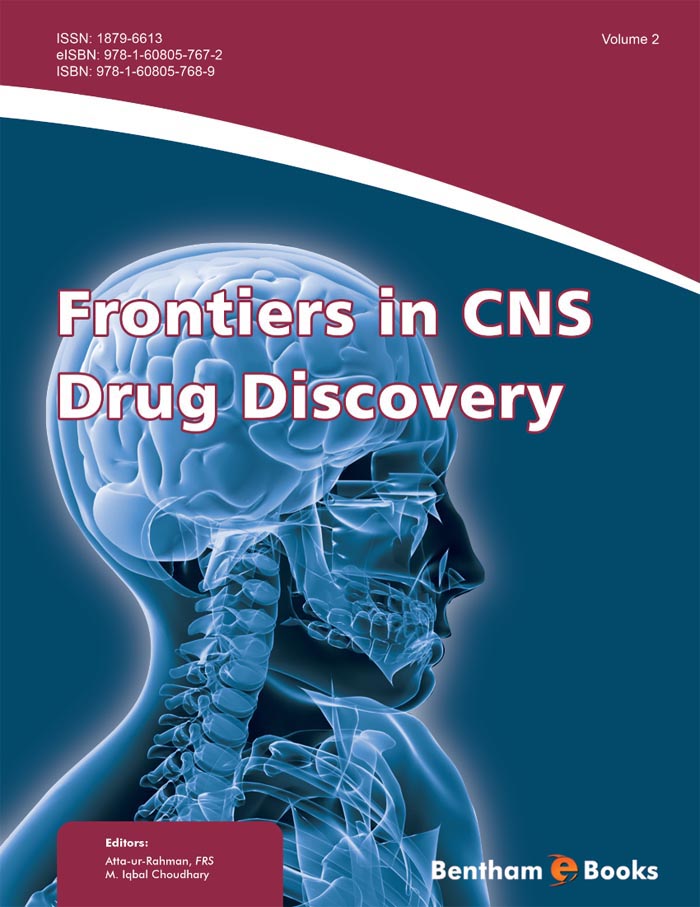The present volume 2 of Frontiers in CNS Drug Discovery brings you the latest medical researches on the human Central Nervous System (CNS). Special themes of the 11 chapters in this volume are animal models, natural medicine, mental disorders, and particularly neurodegeneration. Neurodegenerative disorders such as Parkinson’s disease (PD), Alzheimer’s disease (AD), Huntington’s disease (HD) and amyotrophic lateral sclerosis (ALS) have huge personal, social and economic impacts.
Brian Appleby’s review examines possible treatment targets for protein misfolding disorders, utilizing the knowledge obtained in the field of prion disease. Prion diseases are rapidly progressing neurodegenerative maladies caused by an abnormal conformer of the native prion protein. Even though prion diseases are relatively rare in humans, other neurodegenerative protein misfolding disorders such as Alzheimer’s and Parkinson’s disease are now known to exhibit prion-like behavior and they are likely to benefit from treatments originally designed to deal with prion disease.
Candace Lewis and Foster Olive discuss the relevant epigenetic mechanisms that modulate gene transcription. They review and summarize the existing literature on epigenetic changes that occur after acute and chronic exposure to or selfadministration of alcohol, psychostimulants, opiates, and nicotine, and studies examining the effects of manipulation of epigenetic processes in reward-related brain regions on addiction-like behaviors. The authors also discuss the possible implications of epigenetic factors as predictors of addiction vulnerability prior to drug exposure. Finally, they review findings from preclinical studies on the effects of pharmacological modifiers of epigenetic processes on addiction-related behaviors, and discuss the advantages and disadvantages of developing novel epigenetic-based CNS therapeutics for the treatment of addiction.
The mammalian brain has the capacity to generate new neurons throughout adulthood through a process referred to as adult neurogenesis. Joana M. Gil- Mohapel et al. review the results obtained in rodent models of AD, PD, and HD with regard to therapies aimed at restoring adult neurogenesis and discuss whether such therapies might have therapeutic relevance for the treatment of these devastating neurodegenerative disorders.
HIV-1 is largely impervious to highly active anti-retroviral therapeutic drugs (HAART). Jean-Pierre Louboutin discuss that since curing CNS HIV-1 is currently not possible, limiting the damage caused by the virus may be a useful approach to treatment. The chapter presents models which offer a better understanding of the pathogenesis of HIV-1 in the brain as well as provide new therapeutic avenues.
Transient receptor potential (TRP) ion channels have been extensively studied over the past few years and they are being ardently explored as targets for drug discovery. Recent findings in the field of pain have established a subset of TRP channels that are activated by temperature and are able to initiate sensory nerve impulses following the detection of thermal, as well as mechanical and chemical irritant stimuli. The review by Merab Tsagareli focuses on the latest developments in the TRP ion channel-related area and highlights evidence supporting TRP channels as promising targets for new analgesic drugs at the periphery and central levels and opportunities for therapeutic intervention.
Antipsychotics (APs) have been used for treating schizophrenia and other severe mental disorders for more than fifty years. The aim of the review by Alessandro De Risio and Davide Carlino is to address the boundaries of polypharmacy with APs, from epidemiological features to clinical significance. The chapter looks at prescription patterns, compares the theoretical rationale of monotheraphy and the pharmacokinetic and pharmachodynamic properties of the combined selective associations of two APs. The reasons for using polypharmacy in routine practice are also discussed in the chapter.
The search for new effective chemical entities, capable of acting in diverse biochemical targets, with new mechanisms of action and low toxicity continues to benefit from modern natural products chemistry that can provide active, sophisticated and complex new lead molecules to drug discovery and development. Claudio Viegas-Jr. et al. discuss in their chapter some contributions of natural products chemistry for the discovery of active constituents in plants, ii herbs and extracts to treat senile neurodegenerative disorders, especially for AD and PD, in the period after the 2000s.
Flavonoids are the most abundant plant polyphenolic substances, and they are found in fruits, vegetables and plant-derived beverages. Quite a few natural flavonoids with potential antioxidants and signaling properties are being investigated to identify preventive neuroprotective compounds to stop the progression of PD. The chapter by Elena González-Burgos’ and Pilar Gómez- Serranillos concentrates on the multiple neuroprotection mechanisms of natural flavonoids in PD, covering the latest preclinical in vitro and in vivo PD animal model studies and clinical trials. It provides an overview and the current challenges that may be helpful for future research.
Inflammation plays an important part in the onset and progress of neurodegenerative diseases. Among new products, omega (n)-3 fatty acids have anti-inflammatory and neuroprotective benefits with few side effects. The chapter by Cai Song reviews the new findings from studies in relationship between inflammation and neurodegenerative disease. It also presents the important role of polyunsaturated fatty acids (PUFA) in the brain and the immune system.
Monoterpenoids and their derivatives are important starting materials for the development of new bioactive substances, including drugs. Many of these compounds exhibit feature substantial CNS activities such as antinociceptive, neuroprotective and anticonvulsant. Konstantin Volcho et al. cover the recent literature on monoterpenoids and their derivatives, exhibiting various types of CNS activity in their review.
Use of zebrafish to identify new CNS drugs by high throughput screening is discussed by Thomas Boyd. Many behavioral assays developed in other animals are available in zebrafish, including assays for locomotion, avoidance behaviors, learning, and conditioned place preference. Zebrafish offer an exciting assays for identification of new medicines to treat disorders due to nicotinic cholinergic and dopaminergic dysregulation including nicotine addiction, schizophrenia, Alzheimer's disease and Parkinson's disease.
I am grateful for the timely efforts made by the editorial personnel, especially Mahmood Alam (Director Publications) and Mrs. Sana Mokarram at Bentham Science Publishers.
Prof. Atta ur-Rahman, FRS
Honorary Life Fellow
Kings College
University of Cambridge

